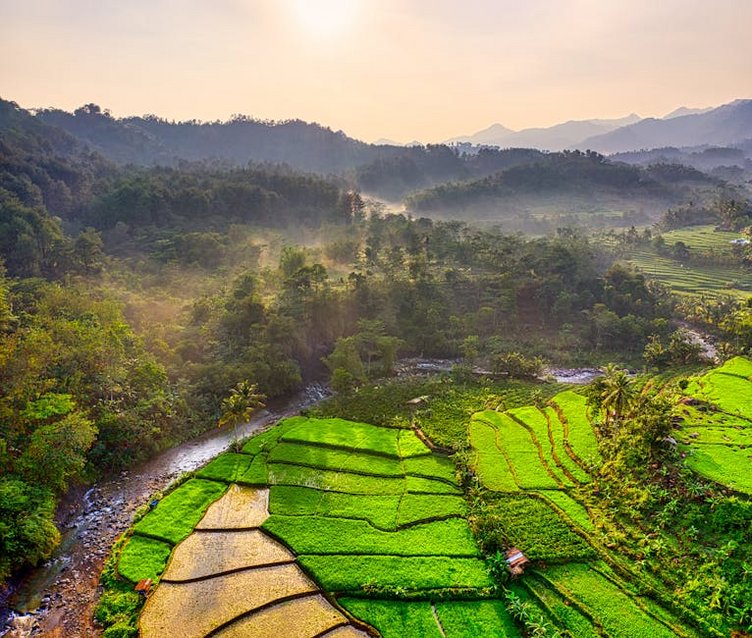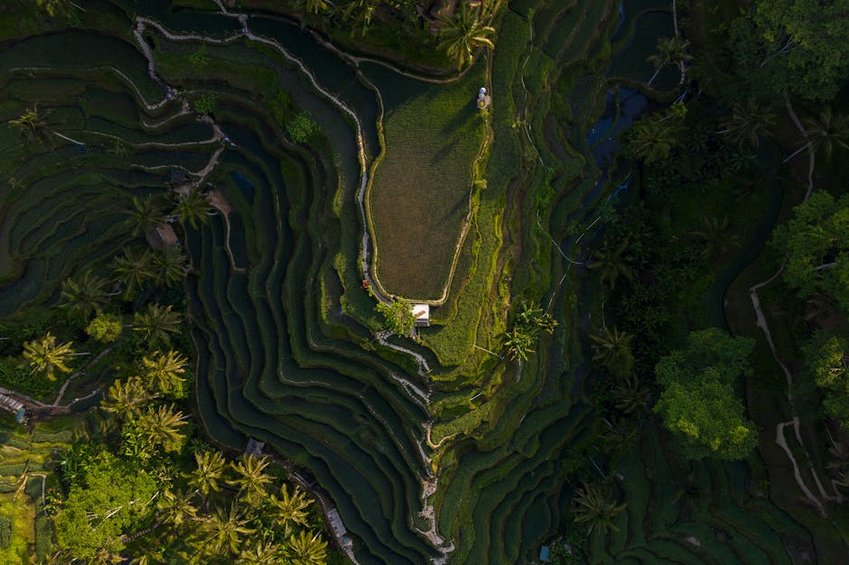Experience the Magical Bali Ubud Rice Terrace Sunrise
Waking up before dawn to witness the Bali Ubud rice terrace sunrise is one of those travel moments that stays with you forever. As the first rays of sunlight gently illuminate the emerald-green paddies, creating a stunning play of light and shadow, you’ll understand why this experience draws photographers, nature lovers, and spiritual seekers from around the world. The cool morning air, the sound of water flowing through intricate irrigation systems, and the sight of local farmers beginning their daily routines all contribute to an atmosphere of pure tranquility. This isn’t just about seeing beautiful landscapes; it’s about connecting with Bali’s agricultural heritage and witnessing a way of life that has remained largely unchanged for generations. Whether you’re an early riser or typically struggle with mornings, making the effort for this sunrise spectacle will reward you with memories that far outweigh any temporary sleep sacrifice. The Bali Ubud rice terrace sunrise offers more than just photographic opportunities—it provides a profound sense of peace and appreciation for the delicate balance between human cultivation and natural beauty.
Bali Ubud Rice Terrace Sunrise – Essential Information
Understanding the basics of the Bali Ubud rice terrace sunrise experience will help you make the most of your visit. These terraces aren’t just scenic landscapes; they represent Subak, Bali’s ancient irrigation system that’s recognized as a UNESCO World Heritage site. The most famous terraces for sunrise viewing include Tegalalang, Jatiluwih, and Campuhan Ridge, each offering distinct perspectives and crowd levels. You’ll want to arrive approximately 30-45 minutes before official sunrise time to secure the best viewing spots and watch as the darkness gradually gives way to golden hour. The experience typically lasts 1-2 hours, depending on how much time you spend exploring the pathways and interacting with local farmers. Remember that these are working agricultural areas, so respect the space by staying on designated paths and not touching the rice plants. The combination of cool morning temperatures, minimal crowds, and optimal lighting conditions makes this morning activity worth every moment of lost sleep.
What You Need to Know – Practical Essentials
- Arrival timing is crucial—aim for 45 minutes before sunrise to experience the full transition from darkness to golden light while avoiding the main tourist crowds that arrive later.
- Proper footwear is non-negotiable; the pathways can be muddy, slippery, and uneven, so wear sturdy shoes with good grip that you don’t mind getting dirty.
- Photography equipment preparation includes bringing a tripod for stability in low light, extra batteries, and lens cloths to combat the morning moisture and potential fogging.
- Local guide services are available and recommended for first-time visitors; they know the best vantage points and can share fascinating insights about rice cultivation traditions.
- Weather contingency planning is wise; Bali’s tropical climate means occasional rain even during dry season, so check forecasts and have a flexible schedule for multiple attempts if needed.
- Budget option ($15-25 USD total) includes scooter rental for transportation, basic entry fee, bringing your own water and snacks, and using a smartphone for photography rather than professional equipment.
- Mid-range experience ($40-70 USD total) covers private driver for 3-4 hours, terrace entry, simple breakfast at a local warung, small donations to farmers, and possibly hiring a local guide for 1-2 hours.
- Luxury package ($100-200+ USD) involves sunrise photography tour with professional guide, premium transportation, breakfast at a high-end restaurant with terrace views, and additional experiences like traditional Balinese blessing ceremonies.
- Complete Guide to Bali Rice Terraces
- Wikitravel Ubud Information
Key Details – Location Specifics
The Tegalalang Rice Terraces remain the most accessible and popular choice for Bali Ubud rice terrace sunrise experiences, located just 20-30 minutes north of Ubud center. However, Jatiluwih offers more extensive, less crowded terraces about 1.5 hours away, featuring stunning panoramic views that make the longer drive worthwhile. Entry fees typically range from $2-4 USD per person, with additional small donations expected if local farmers guide you to particularly photogenic spots. The terrain involves significant walking on steep, narrow paths between paddies, so reasonable physical mobility is required. Most visitors combine their sunrise experience with breakfast at one of the terrace-side cafes that open early, allowing you to enjoy the view while sampling local coffee and traditional Balinese snacks as the day properly begins.
Bali Ubud Rice Terrace Sunrise – Planning Your Trip
Strategic planning transforms your Bali Ubud rice terrace sunrise from a simple photo opportunity into a deeply memorable experience. You’ll need to consider transportation arrangements since public options are limited early morning, making private drivers or scooter rentals the most reliable choices. Accommodation location matters significantly; staying in central Ubud or nearby villages like Tegallalang reduces travel time and allows for extra sleep. Budgeting should include not just the terrace entry fee but also transportation costs, possible guide fees, and money for breakfast and souvenirs from local vendors. The experience fits beautifully into broader Bali itineraries, often combined with visits to Ubud’s sacred monkey forest, water temples, or artisan villages later the same day. Remember that while the sunrise itself is free to witness, the infrastructure around it requires financial support to maintain these cultural landscapes for future generations.
Best Time to Visit Bali Ubud Rice Terrace Sunrise
Timing your Bali Ubud rice terrace sunrise visit perfectly depends on both seasonal and daily considerations. April through October represents Bali’s dry season, offering clearer skies and more reliable sunrise viewing conditions, though June to August brings peak tourist crowds. The wet season from November to March still provides beautiful moments, with dramatic cloud formations and lush, vibrant green terraces, though morning rains can occasionally disrupt plans. Sunrise times vary from approximately 6:00 AM to 6:30 AM throughout the year, so check specific dates for precise timing. Weekdays naturally see fewer visitors than weekends, and arriving during shoulder months like April, May, September, or October often provides the ideal balance of good weather and manageable crowds. The terraces themselves change appearance throughout the growing cycle, with planting season (usually December-January) creating beautiful mirror-like effects from water-filled paddies.
Budget Planning and Costs
Essential Preparation Checklist
Proper preparation ensures your Bali Ubud rice terrace sunrise experience is comfortable, safe, and photographically rewarding. Begin by checking sunrise times for your specific dates and setting multiple alarms since tiredness after long travel days can cause oversleeping. Pack a small backpack with water, insect repellent (mosquitoes are active at dawn), a light jacket for cool mornings, and cash in small denominations for entry fees and incidental purchases. Photography enthusiasts should charge all equipment overnight, format memory cards, and pre-set camera settings for low-light conditions to avoid fumbling in the dark. Inform your accommodation about your early departure if you need packed breakfast arrangements, and confirm transportation the evening before to avoid last-minute disappointments. Mentally prepare for some physical exertion with steep pathways and many steps, but know that the breathtaking views provide ample motivation throughout the climb.

Bali Ubud Rice Terrace Sunrise – Top Attractions and Activities
Beyond simply watching the sunrise, the Bali Ubud rice terraces offer numerous activities that enrich your understanding of Balinese culture and agriculture. The most popular terraces each provide unique experiences: Tegalalang features those iconic sweeping curves and convenient accessibility, while Jatiluwih’s vast UNESCO-protected landscapes offer longer, more immersive walking paths through less-commercialized areas. Many visitors don’t realize that you can participate in brief rice farming experiences where local farmers demonstrate planting or harvesting techniques—these interactions create meaningful connections and deeper appreciation for the labor behind these beautiful landscapes. The early morning hours also present excellent birdwatching opportunities, with various species becoming active as the sun rises. Several terraces have strategically placed swings, photo platforms, and viewpoints that become increasingly crowded later in the day, making sunrise the perfect time to enjoy these installations with minimal waiting and better lighting for photography.
Must-See Highlights
Your Bali Ubud rice terrace sunrise itinerary should prioritize several key highlights that define the experience. The viewpoint at Tegalalang’s main entrance provides that classic photograph perspective with layered terraces receding into the distance, perfectly framed by palm trees and often with Mount Agung visible on clear days. The less-visited northern sections of Tegalalang offer equally stunning views with significantly fewer visitors, allowing for more peaceful contemplation and uninterrupted photography sessions. At Jatiluwih, the walking trail along the ridge delivers breathtaking panoramic views across seemingly endless terraces, with the morning light creating incredible depth and texture across the landscape. Don’t miss the opportunity to walk down into the terraces themselves after sunrise, following the narrow paths between paddies to observe the intricate subak irrigation channels up close and perhaps encountering farmers beginning their workday with traditional tools and methods.
Hidden Gems and Local Favorites
Venturing beyond the main tourist spots reveals several hidden gems that make your Bali Ubud rice terrace sunrise experience truly special. The Penglipuran Traditional Village near Bangli features beautifully maintained terraces with a unique community-based tourism approach, offering sunrise views in a more authentic, less-commercialized setting. For something completely different, the Sidemen Valley terraces provide a spectacular alternative with dramatic volcanic backdrops and virtually no crowds, though the longer drive requires very early departure from Ubud. Many locals prefer the early morning atmosphere at lesser-known terraces like Soka or Blahbatuh, where you might have entire sections to yourself while still enjoying magnificent sunrise views. Seek out the small family-owned warungs (eateries) that open early specifically for sunrise viewers; these spots serve incredibly fresh coffee and traditional breakfast dishes while offering terrace views without the entrance fees of more famous locations.
Bali Ubud Rice Terrace Sunrise – Practical Travel Information
Navigating the practical aspects of your Bali Ubud rice terrace sunrise adventure ensures a smooth, enjoyable experience from start to finish. Transportation requires advance planning since public options don’t operate early enough for sunrise viewing; hiring a private driver for 3-4 hours typically costs $25-40 USD, while scooter rentals offer flexibility for around $5-10 USD per day. Accommodation choices significantly impact your morning experience; staying in Tegallalang village itself allows walking access to some terraces, while Ubud central accommodations require 20-30 minute drives. Communication preparations include downloading offline maps since cellular service can be spotty in terrace areas, and learning a few basic Indonesian phrases enhances interactions with local farmers and vendors. Remember that these are living cultural landscapes, not just tourist attractions, so respectful behavior—including appropriate clothing, not littering, and asking permission before photographing people—helps maintain the delicate balance between tourism and traditional life.
| Category | Options/Features | Price Range (USD) |
|---|---|---|
| Transportation | Private driver (3-4 hours), Scooter rental, Taxi service | $25-40, $5-10, $15-25 |
| Accommodation | Homestays near terraces, Ubud hotels, Luxury resorts | $15-40, $50-150, $200+ |
| Tour Packages | Basic sunrise tour, Photography tour, Cultural experience | $30-50, $80-120, $60-90 |


